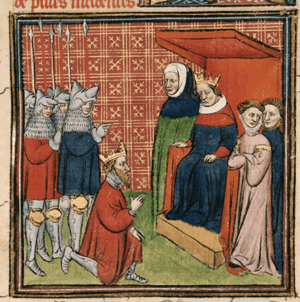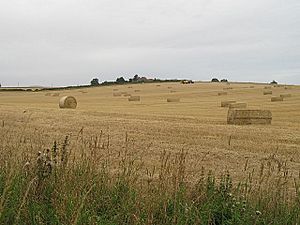Battle of Dunbar (1296) facts for kids
Quick facts for kids Battle of Dunbar |
|||||||
|---|---|---|---|---|---|---|---|
| Part of the First War of Scottish Independence | |||||||
|
|||||||
| Belligerents | |||||||
| Commanders and leaders | |||||||
| John Balliol | John de Warenne, 6th Earl of Surrey | ||||||
| Strength | |||||||
| Hundreds of cavalry | Hundreds of cavalry | ||||||
| Casualties and losses | |||||||
| Unknown | Unknown | ||||||
| Official name | Battle of Dunbar I | ||||||
| Designated | 14 December 2012 | ||||||
| Reference no. | BTL31 | ||||||
The Battle of Dunbar was a very important fight in 1296. It was part of the First War of Scottish Independence. King Edward I of England invaded Scotland because King John Balliol refused to help him in a war against France. This battle was the main land fight of that year's war.
Contents
Why Did the Battle of Dunbar Happen?
After attacking and taking the town of Berwick-upon-Tweed, King Edward I stayed there for a month. He made sure the town's defenses were strong. On April 5, King John Balliol sent a message to Edward. John said he would no longer obey Edward as his king. Edward was not angry, but he said, "If he will not come to us, we will go to him."
The next target for Edward's army was Dunbar Castle. This castle was a few miles from Berwick. The owner of the castle, the Earl of March, was on Edward's side. However, his wife, Marjory Comyn, allowed Scottish soldiers to take over the castle.
Edward sent one of his top commanders, John de Warenne, 6th Earl of Surrey, to attack Dunbar Castle. Surrey was also King John Balliol's father-in-law. The Scottish defenders inside the castle sent messages to King John. John was with his main army nearby in Haddington. He asked for urgent help. In response, a large part of the Scottish army marched to help Dunbar. King John, however, did not go with them.
How the Battle Unfolded
The Battle of Dunbar was mainly a fight between two groups of armored horsemen, called cavalry. The English cavalry was led by the Earl of Surrey. The Scottish cavalry was partly led by the Comyn family.
The two armies saw each other on April 27. The Scottish army was on high ground to the west. To reach them, Surrey's cavalry had to cross a dip in the land with a small stream called the Spott Burn. As the English crossed, their lines broke up. The Scots thought the English were running away. So, they charged downhill in a messy way.
But the English had quickly reformed their lines on the other side. They were ready and attacked the disorganized Scots. The English won very quickly. The battle was short and not many soldiers died. One Scottish knight, Sir Patrick Graham, was killed. About 100 Scottish lords, knights, and soldiers were captured. Some English sources claimed over ten thousand Scots died, but this was likely a mistake. It was probably confused with the many deaths when Berwick was attacked.
The Scottish soldiers who survived ran west towards the Ettrick Forest. The next day, King Edward I arrived at Dunbar. Dunbar Castle then surrendered to him. Many important Scottish leaders were captured. These included John Comyn, the Earl of Buchan, and the earls of Atholl, Ross, and Menteith. About 130 other knights and squires were also taken prisoner. All of them were sent to prisons in England.
What Happened After the Battle?
The Battle of Dunbar was a big English victory. It mostly ended the war of 1296. The rest of the fighting was mainly about taking control of Scottish lands.
Many Scottish castles surrendered easily. James Stewart, a powerful Scottish leader, gave up Roxburgh Castle without a fight. Other castles quickly followed his example. Only Edinburgh Castle held out for a week against Edward's siege machines. King John had fled north to Forfar. A Scottish group sent to help him was told to save themselves instead.
King Edward I kept his word and chased King John into central and northern Scotland. Stirling Castle, which guarded an important crossing of the River Forth, was empty except for a caretaker. This person handed the keys to the English. John reached Perth on June 21. There, he received messages from Edward asking for peace.
King John Balliol surrendered to Edward. He had to go through a very humbling experience. On July 2, at Kincardine Castle, he admitted he had rebelled and asked for forgiveness. Five days later, in the churchyard of Stracathro, he gave up his treaty with the French.
The final humiliation happened on July 8 in Montrose. John was dressed in his royal clothes for the event. Then, Antony Bek, the Bishop of Durham, publicly ripped the red and gold Scottish royal symbols from John's coat. This act gave John the nickname Toom Tabard, which means "empty coat." This is how Scottish schoolchildren have known him for hundreds of years. John and his son Edward were sent south to be prisoners. Soon after, King Edward I followed. He took with him the Stone of Scone and other important Scottish treasures.
The Battlefield Today
The area where the battle took place is now protected by Historic Scotland. It was added to the Inventory of Historic Battlefields in Scotland in 2012. This means it is an important historical site.
Historic Environment Scotland says that no old battle items have been found there yet. A dig in 2007 did not find anything related to the battle. However, experts believe that weapons and other metal objects from the battle might still be hidden in the soil.
See also
 In Spanish: Batalla de Dunbar para niños
In Spanish: Batalla de Dunbar para niños



